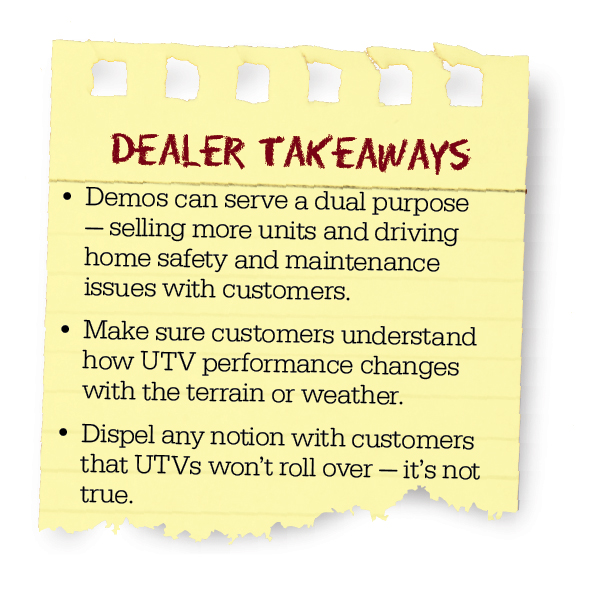Utility task vehicles (UTVs) are the new workhorses on rural acreages and offer equipment dealers a way to increase their rural lifestyle customer base.
Dealers can highlight the ability of UTVs to transport, tow, haul and more, but they also must warn customers that UTVs can cause serious injury or death when operated incorrectly.
“These are safe units when operated safely,” says Charles Schwab, Iowa State Univ. Extension safety specialist. “Dealers can help elevate the understanding of the risk assessment.”
Here’s what dealers can do to keep their UTV customers safe.
Safety During the Sale
Lead with the “who, what, where” questions, says Geoff Stewart, lead engineer with Club Car. Who will use the vehicle? What are the jobs? Where will you drive it?
Stewart says manufacturers are committed to safety, but can’t eliminate every risk, so dealers should point out the warning labels, especially the ones addressing seat belt use and not operating on public roads.
Joel Hicks, technical support supervisor for Kioti Tractor, says dealers can point to sales features as safety benefits, such as the rollover protective structures (ROPS).
Demonstration is critical during the sale, experts say. Stewart advises dealers follow the Boy Scouts’ teaching model: explain, demonstrate, guide, enable. Use off-road terrain on your dealership’s property or arrange to use land nearby.
Pre-Operation Checklist
Stress that safety begins before the engine is running. Experts say dealers should refer customers to the operator’s manual for manufacturer recommendations, but emphasize these pre-operation checks:
- Tires and wheels – air pressure, bolts secured
- Controls – steering, brakes, throttle
- Lights and electrical system
- Oil and fuel
- Seat belts and ROPS inspection
Operation Do’s and Don’ts
Some safety guidelines are still being defined for this relatively new market. Stewart says there is debate within the industry whether helmets are required. Kioti advises wearing helmets when using UTVs on trails.
Experts say many customers use UTVs more for recreation than work. Regardless of its use, dealers can make safety part of the mindset. Some critical operation do’s and don’ts:
- Drivers should be 16 or over and have a valid driver’s license.
- Only drive from the driver’s seat. The driver and passengers should remain seated and use the seat belts. Keep body inside the vehicle.
- Pay attention to loads. Make sure it’s centered and secured properly.
- Do not leave children in the vehicle unattended.
- Never drive on public roads.
- Follow safe driving strategies (detailed in the operator’s manual) regarding safe starting and stopping procedures, driving slowly into turns, going straight up and down slopes and no jumping or extreme braking.
- Paying attention to the dangers from fuel, pinching or crushing from beds and attachments, or possible rollover during maintenance.
- Never modify the vehicle or
attachments.
Setting the Record Straight
Hicks says a customer misconception is that UTVs won’t roll over, but that’s not true. Unsafe operation can cause a rollover.
Schwab says safe operation changes each time a customer operates the vehicle. For instance, the trail may change after a rain and different loads affect safe driving strategies.
Your goal as a dealer, says Stewart? “Make sure all the information is properly turned over when they leave, with all the questions answered.”
Schwab warns: “There are no accidents — only poor decisions leading to injuries and fatalities.”






Post a comment
Report Abusive Comment